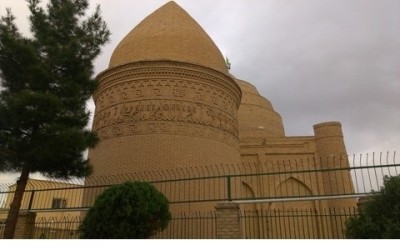One of the main issues of Iranian art and architecture is the presence of numerous towers with various names and functions throughout the country. Despite being obsolete in the context of modern heterogeneous architecture, these towers provide a fascinating glimpse into the dark angles of medieval era. To explore these towers mostly constructed in the Ziyarid and Saljuq era we travel to Damghan, one of the central cities of Iran. Damghan, the main city of Ghumes[1] spent one of its glorious periods in the time of the Buyid (945-1055), Ziyarid (928-1042), and the Saljuq (1029-1194) dynasties. The presence of many monuments verifies this fact.
The architecture of the 10th and 11th centuries is characterized by the construction of several towers, whose brick decorations evoke naked nobility under the sun. Chehel Dokhtar (forty girls) tower is an example of this simple naked nobility.
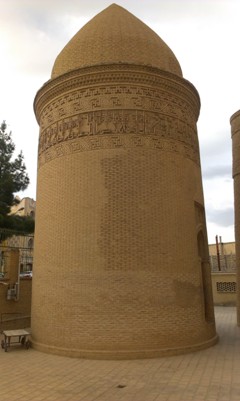
The tower’s cylindrical body is based on an exact mathematical plan to resist natural disasters. Its height is 5/15 ms, its external environment 23 ms and its internal diameter is 5/5ms (Hatam, 2000, p. 107). The entrance is 2/55 to 1/87 ms with a crescent arch. Its inner wall is covered with plaster and is paved with brick. There is a tomb that does not fit the structure of the tower. It seems that it has been established later.
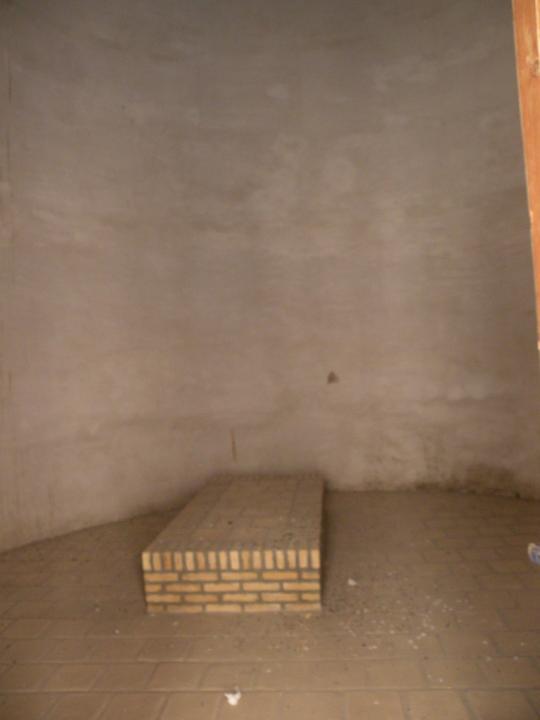
The tower is located in the backyard of Muhammad and Jafar shrines in the lower ground, which makes the tower left isolated. The shrine has two entrances. While it is mandatory for women to be shrouded in the shrine if we enter from the back door at the start of Chehel Dokhtar tower, there is no need to cover up as long as you are in the tower's area, so you can feel comfortable in the privacy of the tower.
Chehel Dokhtar tower has two opposite states; being located in the margin of Muhammad and Jafar shrines and its closed-door leave visitors in a remote sense of isolation. On the other hand, being in the adjacent of these two shrines which are honored highly by people has facilitated its survival; especially in the conditions that Chehel Dokhtar Tower in Semnan and Tugrul Tower in Mehmandoust have been left abandoned.
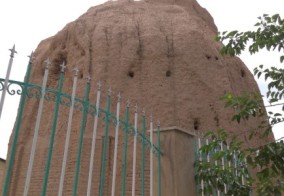

Chehel Dokhtar Tower in Semnan Tugrul Tower in Mehmandoust
The title “Chehel Dokhtar” or “Chehel Dokhtaran” is related to the Iranian pre-Islamic Era. It is probable that the Chehel Dokhtar tower in Damghan like the one in Semnan is primarily made of “adobe” and was reconstructed in the 11th century with brick and a conical roof (Haqigat, 2001, p. 315).
Khanikov specifies that this tower was established by Amir Abu Shoj ā’ Askar Beq ibn Isfah ā n in 1054-1055 (Khanikov, 1996, p. 87). “be bana’a haza al-boq’at al-jalil abu shoja’” is some parts of the inscription of the tower “Haqiqat, 1991, p. 314”.
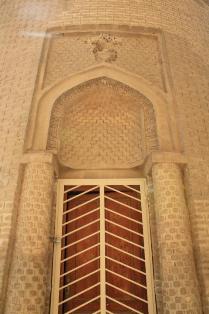
The Iranian brick buildings, whose tipping point is manifested in brickwork, are composed of two elements of soil and water. Monuments like Chehel Dokhtar Tower are decorated with brick regarding their structures (Varjavand, 1987, pp. 307-309). Being constructed based on Qabus Dome Chehel Dokhtar is not emblished with enameled tiles in order to exhibit its delicate simplicity and nakedness. Using calligraphy instead of an image to decorate buildings was customary in Iranian medieval architecture. Chehel Dokhtar tower is trimmed with Kufic calligraphy, which was common in the 10th and 11th centuries (Mokhlesi, 1987, pp. 287 & 290).
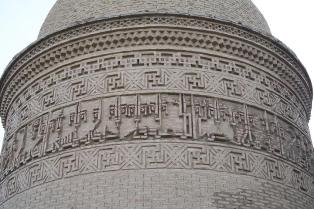
The main function of this tower, like many others, is controversial. The spread of mysticism and Sufism, in whose light many tombs and shrines were built, had direct effects on the functional aspects of architecture. On the basis of its inscription, Chehel Dokhtar Tower seems to be a family tomb (Shayestefar, 2002, 67). In light of interdisciplinary studies and applying linguistics and architecture, Dr. Bastani Parizi has proposed a remarkable hypothesis about the function of Chehel Dokhtar in Damghan and other similar buildings, which we will explore in the next paper.
References
Abu al-Fada, Isma’il ibn Ali (1966). Taqvimāl-boldān, Tehran: Bonyad-e Farhang-e Iran.
E’temād al-Saltana, Muhammad Hassan (1983), Matla’ al-šams, ed. Teimur Borhan Limudehi, Tehran: Farhangsara.
Hakim, Muhammad Khan (1975). Ganj-e dānesh, Tehran: Zarrin.
Hamawi, Yaqut ibn Abdollah (1965). Mo’jam al-boldān, v. 4, Tehran: Sa’di.
Haqiqat, Abdol Rafi’ (2001). Tariḵ-e Ghumes, Tehran: Kumes.
Hatam, Qolam Ali (2000). Me’mariya Eslāmiya Iran dar doreya Saljuqiān, Tehran: Jihad Daneshgahi.
Ibn-i Faqih-i Hamedani, Ahmad ibn Muhammad (1970). Moḵtasar al-boldān, tr. H. Masoud, Tehran: Bonyad-i Farhang-e Iran.
Khanikov, Khanikov (1996). Safarnāmaya ḵānikov, tr. Aqdas Yaqmai’i & Abol Qasim Bigonah, Mashhad: Astan-e Quds.
Maqdasi, Muhammad ibn Ahmad (1982). Ahsan al-taqāsim fi ma’refat al-aqālim, tr. Ali Naqi Monzavi, Tehran: Moalefan wa Motarjeman-i Ketab.
Mas’udi, Ali ibn Hossein (1970). Al-tanbih wa al-ešrāf, tr. Abul Qasim Payanda, Tehran: Bongah-e Tarjoma wa Nashr-e Ketab.
Mashkur, Muhammad Javad Rajabnia, Mas’ud (1988). Tāriḵ-e siyāsi va ejtemā i’ya Aškāniān, Tehran: Donyaya Ketab.
Mokhlesi, Muhammad Reza (1987). Manāreha, Me’māriya Iran, ed. Muhammad Yusef Kiani, Tehran: Ershad-i Eslami.
Musavi, Ahmad (1989). Tāriḵ-e šahr-e Dāmghān, Tehran: Faza.
Shayestefar, Mahnaz, “Maqbareya Chehel Dokhtarān-i Dāmqān”, Honarhaya Tajasomi, 2002, 16, pp. 64-68.
Varjavand, Parviz (1987). Tazi’nāt-i Me’māriya Eslāmi, Ajorkāri, Me’māriya Iran, Honar-i Eslāmi, ed. Muhammad Yusef Kiani, Tehran: Ershad-i Eslami.
Yaqubi, Ahmad ibn Eshaq (1968). Al-Boldān, tr. Ebrahim Ayati, Tehran: Tarjoma va Nashr-i Ketab.
….(1939). Mojmal al-tavariḵ va al-qesas, ed. Muhammad Taqi Bahar, Muhammad Ramezani,Tehran: Kolaleya Khavar.
Maryam Kamali
[1] . Ghumes was one of the main provinces of Parthian empire (247 BC–224 AD) (Mashkur, Rajabnia, (1988), p. 136); Ghumes was included Damghan, Semnan, Zaqana, Biyar and Maqun (Maqdasi (1982), p. 48; Mas’udi (1970), pp. 518-519). To learn more about Ghumes see Ibn-i Faqih-i Hamedani(1970), p. 167; Yaqubi (1968). P. 52; Hakim, 1975, p. 862; E’temā d al-Saltana (1983), v. 3, p. 256; Abu al-Fada (1966), p. 498; Hamawi (1965), v. 4, p. 203.

